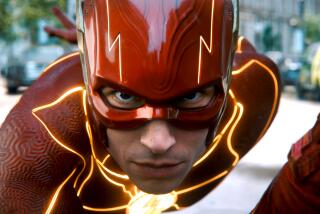Box office: How ‘Twilight’ and ‘Harry Potter’ are radically different
- Share via
In many respects, the “Harry Potter” and “Twilight” movies have a lot in common. They’re both wildly successful film franchises based on popular young-adult books. They both inspire a cult-like, camp-out-all-night devotion. They both took a shake-it-up-approach to directors before winding down with a single filmmaker. And of course they both made Beatles-esque stars out of their previously unknown actors.
All these similarities would make you think that they’re pretty similar phenomena at the U.S. box office too. But over the course of their lifetimes--Potter ending in summer ’11 and the Kristen Stewart-Rob Pattinson series of course wrapping up this weekend with “Breaking Dawn Part 2”--they’ve in fact behaved in radically different ways, ways that I’d submit suggest some interesting things about both the properties and their fan bases.
For starters, Potter opening weekends tended to vary in strength quite a bit, far more than “Twilight” opening weekends.
Let’s take a look at each franchise’s three November sequels. (It’s a good test group, since it controls for many of the major variables.)
The “Potter” trio’s openings were all over the map. One film, 2002’s “Harry Potter and the Chamber of Secrets,” opened to a (comparatively) modest $88 million. Another, 2010’s “Harry Potter and the Deathly Hallows Part 1,” opened to a whopping $125 million. And a third, 2007’s “Harry Potter and the Goblet of Fire,” opened in-between, with $102 million. Overall, the variance is quite large--over 40%.
On the other hand, the three Twilight sequels that opened in November (“New Moon,” “Breaking Dawn Part 1” and “Breaking Dawn Part 2”) performed almost identically. Scarily so, in fact. The three movies opened, respectively, to $143 million, $138 million and $141 million,barely a 3% difference between the highest and lowest numbers.
Part of this discrepancy, of course, is a function of “Potter” playing out over 10 years instead of “Twilight’s” four. The swing between the opening totals of “Chamber of Secrets” and “Deathly Hallows Part 1,” for instance, came over an eight-year period.
But that’s not always true. There were big “Potter” swings even over short periods —say, the $47 million between “Half-Blood Prince” and “Deathly Hallows Part 1” in successive years, or $26 million between “Order of the Phoenix” and “Goblet of Fire” two years apart.
Have a look at another, slightly more sophisticated measure: the point in a franchise’s life cycle when the series found the most success.
“Twilight” charts a pretty simple graph. The first film was the lowest performer--a $191-million domestic total--as some fans had yet to discover it.
That took a sharp upturn with the second film, “New Moon,” which garnered $297 million. And there the numbers stayed: “Eclipse” took in $301 million, while “Breaking Dawn Part 1” garnered $281 million. (“Breaking Dawn Part 2” will probably land right in that range, maybe just a smidge higher.)
“Potter,” once again, is an across-the-map adventure. The second-most successful movie of the entire canon was in fact the first-ever film, “Harry Potter and the Sorcerer’s Stone,” which took in $318 million when it came out in 2001. From there the totals actually dropped off (the immediate follow-up, “Harry Potter and the Chamber of Secrets,” sunk to $262 million). They wouldn’t reach the heights of the first film until the final movie 10 years later, when “Harry Potter and the Deathly Hallows Part 2” garnered a hefty $381 million.
If you were drawing “Potter’s” box office totals on a graph, it would look roughly like a U, with the first and last movies the highest points, and all the others at various points below.
All of this adds up to more than just numbers on a page, of course. It shows that Potter is a far more dynamic franchise, audience-wise. It lost fans, then gained some back, lost some again and then picked them back up. As you might expect, this is generally how it goes with franchises that run a while.
“Twilight” is a much different story. The Stephenie Meyer-based vampire series established itself--and stayed there. The people who came out early came out later. The people who ignored it at the start generally continued to ignore it as the years moved on.
After this weekend, we won’t see much of “Twilight” again.” The numbers tell us how we feel about this culturally. There’s a large, well-defined group that will really miss the series. And then there’s the rest of us, who never really got what the fuss was about in the first place.
ALSO:
Final Twilight film just shy of opening-weekend box office record
Twilight:Breaking Dawn Part 2 narrowly escapes R-rating
Twilight tent city: Hundreds camp out awaiting L.A. premiere
Follow me on Twitter at https://twitter.com/ZeitchikLAT
PHOTOS AND MORE
VIDEO: A guide to upcoming movies
The Envelope: Awards Insider
PHOTOS: NC-17 movies: Ratings explained
More to Read
Only good movies
Get the Indie Focus newsletter, Mark Olsen's weekly guide to the world of cinema.
You may occasionally receive promotional content from the Los Angeles Times.











